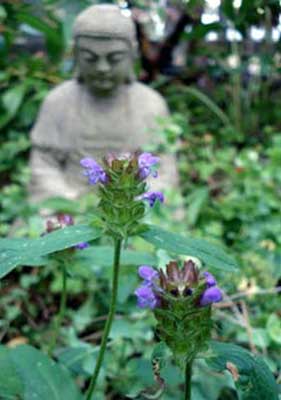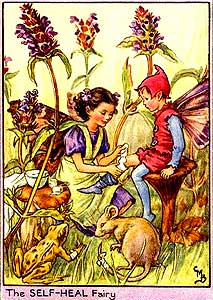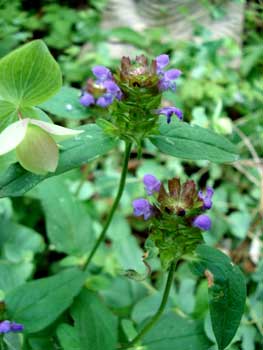
Common Selfheal
When little Elves have cut themselves,
Or Mouse has hurt her tail,
Or Froggies arm has come to harm,
This herb will never fail.
The Faeries skill can cure each ill
And soothe the sorest pain;
She'll bathe and bind,
and soon they'll find
That they are well again.
-Cicely Mary Barker
(1895-1973)
(1895-1973)
 Prunella vulgaris is a small flowering perennial of the mint family, known variously as Common Selfheal (or Self Heal), Heal-All, All Heal, Woundwort, or Heart-of-the-Earth, highly regarded in many cultures for its medicinal qualities.
Prunella vulgaris is a small flowering perennial of the mint family, known variously as Common Selfheal (or Self Heal), Heal-All, All Heal, Woundwort, or Heart-of-the-Earth, highly regarded in many cultures for its medicinal qualities.Hence Cicely Mary Barker in one of her famous flower fairy illustrations depicted the Selfheal Fairy as a tiny Florence Nightingale who tended to the injuries of her fellow fairies & little woodland creatures.
This plant introduced itself into our garden, as it is a common weed throughout the the northern hemisphere & beyond ‚- found everywhere from Europe, Asia, Japan, Hawaii, North & South America. It was not formerly in the Americas, but seriously wanted to colonize the rest of the world. In North America it is now found from coast to coast & all states & provinces in the middle.
It can be invasive yet seems not to be a watchdogged plant, nor regarded as noxious. In any case, it's too thoroughly naturalized to worry about, & even has a high benefit as a choice host-plant for the clouded sulphur butterfly (Colias philodice), as well as providing nectar for just about all adult butterflies & bees.
It is very commonly gardened, so when it showed up on its own I did not discourage it. It's not deeply rooted so if it shows up where I don't want it, it's very easily removed. It is delicate enough in its habbits that it is not at all threatening to intentional plantings.
 It's exceedingly pretty & humble. It creeps about semi-vine-like with its small elongated oval leaves, & sends up stems only about a foot high with a flower reminiscent of betany but not as showy, subtler in its beauty.
It's exceedingly pretty & humble. It creeps about semi-vine-like with its small elongated oval leaves, & sends up stems only about a foot high with a flower reminiscent of betany but not as showy, subtler in its beauty.In our garden it self-selects only well-watered areas of the garden, usually but not invariably in bright shade, despite that it is often encountered in mesic (dry) habitats & open fields on any country walk.
It can flower as early as May & rebloom well into Autumn, though the patch I've most encouraged only blooms really well in June, then stops blooming by month's end, & takes up blooming anew a week or two later.
A patch can creep around spreading rapidly, never thick enough to displace anything. Hardy & swift-spreading though it is, a given patch tends to get weaker & die out after a few years, though somewhere nearby it will invariably have self-seeded. I only recently noticed it does seed into sunny spots as well as shady, & forms a low small mat of leaves; but in the sunny locations doesn't bloom even though the foliage doesn't look stressed.
The leaves & young flower heads are edible in salads, or brewed in teas as a traditional tonic. It's a basic "witch's herb" & traditional curative. The whole plant contains an array of chemical constituents that have had a lot of lab-studies conducted, & seems really to have medicinal value, with a proven antibacterial capacity (shared with most mints).
If it were used primarily for such things as oral hygiene, nothing negative could be said about its probable value. However, very vaguely hopeful-seeming findings regarding effect on serious illnesses really only amount to "might not be entirely worthless."
A few suggestive scientific findings have been insanely exaggerated by vendors of herbal remedies pitching it for use to battle everything from herpes to diabetes to cancer & AIDs. These wild claims should not be taken as evidence that selfheal can be used to circumvent more credible medical treatment, whether or not it is a tad less phony than most magic-cure herbs marketed by hucksters who seriously don't have your health in mind, their industry sustained chiefly by gullibility & superstition.
Gratitude is extended to Linda Ellis & the folks at the
Washington Native Plant Society
for identifying this volunteer to my garden for me.